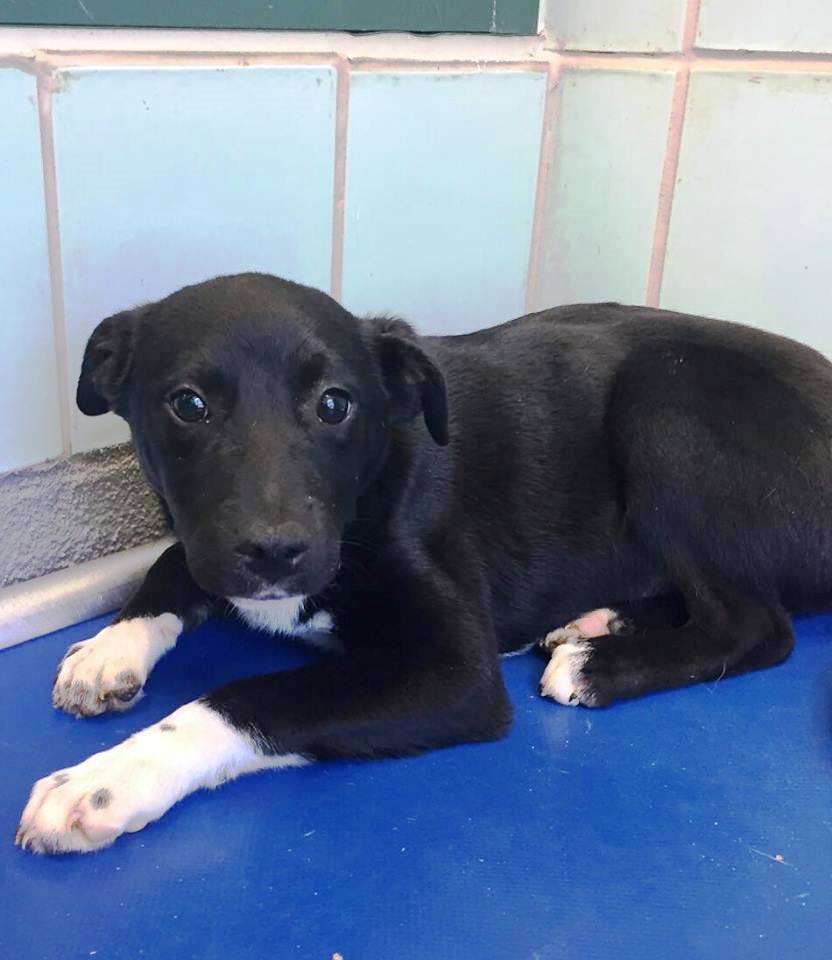
A strange thing happened to me a few weeks ago: I fell in love with an animal. It was a complete surprise, and my daughter’s fault. She and I went out for a Dad and Daughter date, the last part of which was visiting San Antonio’s Japanese Tea Garden. As we wandered over the paths, we made our way out of the garden and down toward the San Antonio Zoo not far away. Then we hard dogs barking, and much to our surprise realized that we were walking by a pet adoption center we did not know was there. Of course we had to go in, and once inside we had to see who was there. As we made our way to the room with the puppies, I was drawn to the very last enclosure where three pups were kept. Two of them were most playful and eager for attention, but the third showed no interest in us when we walked in the little room. In fact, she ducked under the little bed on which she had been laying. Thanks to my daughter the pup didn’t stay there long; she reached in and pulled her out so the two of us could get acquainted. That was when I knew I had met my dog. Without doing anything other than sitting still in my arms, this little dog crawled into my heart in a way no other animal has ever done. It did not take long before we decided to adopt, and now for the first time in my life I have a dog.
Little Blue, as we call her, has been with us less than a month. In that short time she has come to enjoy her new home, gaining confidence each day in herself and her new family. She is far from the timid, fearful little pup I first saw last month. Although she has much yet to learn, she is showing the signs of great affection, keen intelligence, and the herding instincts one would expect of a cattle dog. I have always enjoyed the company of animals, but Blue is helping me understand something very important: the health of our God’s creation depends on the interaction of human beings with animals.
In this modern age, with our mega-cities and technological wonders, it is easy to forget that humanity has only within the last two centuries developed the ability to do things without the aid of animals. Today we travel by automobile, train, and airplane; we communicate by telephone and internet, and we use great engines to build our cities and tend our farms. Yet for most of our existence on this planet we could have done very little without our animals. Mules, camels, and llamas provided reliable long-distance transport, horses conveyed men and messages swiftly, and carrier pigeons allowed for even more rapid communication. Our heavy construction equipment was elephants, buffalo, and oxen, and instead of synthetic fabric we relied on wool from our sheep and hair from our goats. Dogs and falcons aided us in hunting, geese guarded our homesteads, swine removed our waste, cats rid our homes of pests, and cows and chickens provided continuous nourishment in the form of milk and eggs. All of these creatures contributed to our wars, and often the presence or absence of a strategic asset like a mule train or well-rested cavalry horses made the difference between victory and defeat.

Falconry illustration from On the Art of Hunting with Birds, Holy Roman Emperor Frederick II (1194-1250) (Wikimedia Commons); Dog rounding up sheep, (“Where do working dogs go when they retire?”, Warren Fyfe News).
Many are the examples of human dependence on animals, and the animals as well depend on humans to fulfill their great potential. A horse is never so swift as when it carries a man. An elephant without proper training is more often than not a hazard to humans, but under the care of an experienced mahout is capable of great wonders, both on the battlefield and in the construction yard. And a dog is nothing more than a ravenous pack animal until contact with humans makes it a faithful companion able to guard the home and guide animals of lesser intelligence.
But what of domestic animals in this modern day? How do they enrich human existence in an urbanized world beset with far too many modern conveniences? This is the lesson Blue is helping me learn. It is a lesson learned in stages, beginning with the communication problem. How are we to understand our animals? Their languages contain no words we can comprehend, nor can we be certain that they comprehend our words, or at least that our words have the same meanings for them that they have for us. It takes effort to learn what our dog means with a whine or a lick of the hand, and what our cat means with a purr or a hiss. It takes as much or more effort to help them understand when to sit or stand, where it is appropriate to relieve themselves, how to walk with us, and what we expect of them when they meet other people and animals. How do we communicate love, compassion, anger, approval, and the subtleties of our daily routine? If we can answer this, then we are on the path toward learning something else from our animals: how our God relates to us.
Does YHVH communicate in words? Sometimes yes, but usually not, or at least not in words we can understand. Does He communicate? Yes, constantly. He communicates to each of our senses, to our hearts and souls, to our minds, and to our spirits. All too often we receive His communication in the same way our dog receives a recitation of the Gettysburg Address: it is incomprehensible and of no relevance to us. Or so we may think. In truth, what our Creator communicates is the very essence of life, both in this reality and in the one to come. Since He made us, He knows the most effective ways to communicate with us, but to do that He must first get our attention. How do we get the attention of our wayward pets? Perhaps a tug on the leash, a loud shout, or exile from our company. It is easy enough to think of parallel actions our Heavenly Father takes with us when we do not pay attention to Him, either through ignorance or through rebellion.
When He has our attention, He still does not have our comprehension. His thoughts truly are farther above us than are our thoughts above those of our animals. This brings us the next lesson from our pets: trust and obedience. They must know we are their providers and protectors, and that in our presence they are safe and secure. If they know this, then they are more likely to do as we bid them. So, too, are we with our Father. He rewards our obedience even as we reward the obedience of our pets, and He disciplines us even as we discipline our pets. With each interaction the foundation of respect, trust, and love grows ever stronger until, in time, we function as one. Is this not so with a well-trained dog? The dog and her master become more than just a team; they are extensions of one another, and thus grow into something far greater than either could be alone. That is what our God desires in His walk with us.
 But there is something more that our animals teach us. We learn from them how to relate to our fellow human beings. Whom do we encounter who cannot communicate in the same way as we? Who cannot understand our words, or respond in the way we expect and desire? Perhaps a child with autism, or a babe in the womb, or even the stranger in our midst. Do we offer them compassion, patience, and mercy, or do we turn away, or reprimand loudly (in incomprehensible syllables), or send them out of our presence, or seek to end their existence? What then of the other difficult and undesirable people in our world – the wayward teenager, the unwashed homeless man, the lonely widow. What do they deserve, our compassion, or the back of our hand? Can we help them when we do not, and perhaps never can, understand why they are as they are? Can we make their lives better even if for a brief moment, and even at our own cost?
But there is something more that our animals teach us. We learn from them how to relate to our fellow human beings. Whom do we encounter who cannot communicate in the same way as we? Who cannot understand our words, or respond in the way we expect and desire? Perhaps a child with autism, or a babe in the womb, or even the stranger in our midst. Do we offer them compassion, patience, and mercy, or do we turn away, or reprimand loudly (in incomprehensible syllables), or send them out of our presence, or seek to end their existence? What then of the other difficult and undesirable people in our world – the wayward teenager, the unwashed homeless man, the lonely widow. What do they deserve, our compassion, or the back of our hand? Can we help them when we do not, and perhaps never can, understand why they are as they are? Can we make their lives better even if for a brief moment, and even at our own cost?
If we can do this for our pets, then perhaps there is hope that we can do it for our fellow humans. And thus we come to the greatest reason God placed animals among us: they are a supreme test of righteousness.
A righteous man has regard for the life of his animal, but even the compassion of the wicked is cruel. (Proverbs 12:10 NASB)

